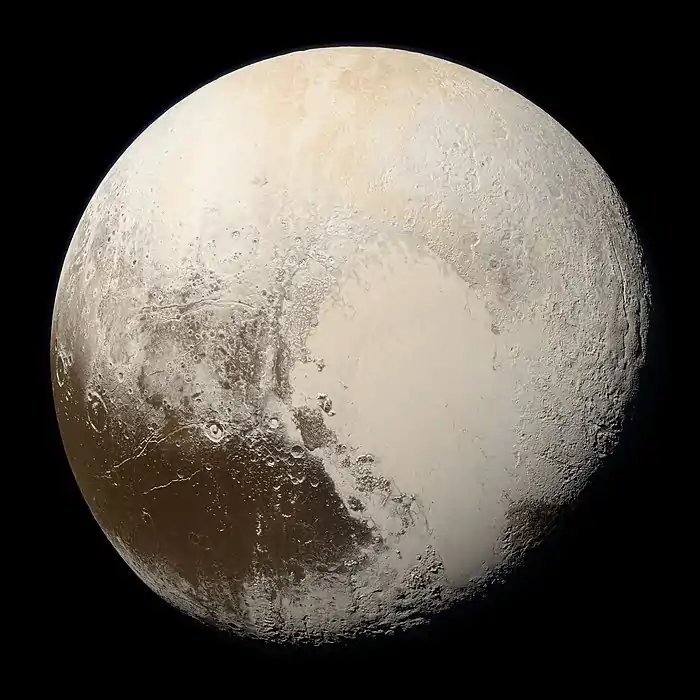2002 XV93
2002 XV93, also written as 2002 XV93, is a trans-Neptunian object (TNO) with an absolute magnitude of 5.4.[5] A 2:3 orbital resonance with Neptune makes it a plutino.[2]
 2002 XV93 imaged by the Hubble Space Telescope in 2005 | |
| Discovery[1] | |
|---|---|
| Discovered by | M. W. Buie |
| Discovery date | 10 December 2002 |
| Designations | |
| 2002 XV93 | |
| plutino[2] | |
| Orbital characteristics[3] | |
| Epoch 13 January 2016 (JD 2457400.5) | |
| Uncertainty parameter 3 | |
| Observation arc | 6582 days (18.02 yr) |
| Earliest precovery date | 16 October 1990 |
| Aphelion | 44.427 AU (6.6462 Tm) (Q) |
| Perihelion | 34.405 AU (5.1469 Tm) (q) |
| 39.416 AU (5.8965 Tm) (a) | |
| Eccentricity | 0.12713 (e) |
| 247.47 yr (90387.1 d) | |
| 282.08° (M) | |
| 0° 0m 14.338s / day (n) | |
| Inclination | 13.281° (i) |
| 19.170° (Ω) | |
| ≈ 20 March 2070[4] ±5 days | |
| 163.53° (ω) | |
| Earth MOID | 33.4096 AU (4.99801 Tm) |
| Jupiter MOID | 28.9574 AU (4.33197 Tm) |
| Physical characteristics | |
| Dimensions | 549.2+21.7 −23.0 km[5] |
| 0.040+0.020 −0.015[5] | |
| |
| 21.1[6] | |
Orbit and rotation

2002 XV93 is locked in 2:3 resonance with Neptune, which means that when it makes two revolutions around the Sun, Neptune makes exactly three.[2]
The rotation period of this object is not known.
Physical characteristics
The size of 2002 XV93 has been measured by the Herschel Space Telescope to be 549.2+21.7
−23.0 km.[5]
It is likely a dwarf planet.[9]
References
- "List of Transneptunian Objects". IAU Minor Planet Center. Archived from the original on 27 October 2010. Retrieved 27 October 2010.
- "MPEC 2010-O39 :Distant Minor Planets (12 August 2010.0 TT)". Minor Planet Center & Tamkin Foundation Computer Network. 27 July 2010. Archived from the original on 20 May 2012. Retrieved 7 August 2010.
- "JPL Small-Body Database Browser: 2002 XV93" (2008-10-23 last obs). Retrieved 30 March 2016.
- JPL Horizons Observer Location: @sun (Perihelion occurs when deldot changes from negative to positive. Uncertainty in time of perihelion is 3-sigma.)
- Mommert, Michael; Harris, A. W.; Kiss, C.; Pál, A.; Santos-Sanz, P.; Stansberry, J.; Delsanti, A.; Vilenius, E.; Müller, T. G.; Peixinho, N.; Lellouch, E.; Szalai, N.; Henry, F.; Duffard, R.; Fornasier, S.; Hartogh, P.; Mueller, M.; Ortiz, J. L.; Protopapa, S.; Rengel, M.; Thirouin, A. (May 2012). "TNOs are cool: A survey of the trans-Neptunian region—V. Physical characterization of 18 Plutinos using Herschel-PACS observations". Astronomy & Astrophysics. 541: A93. arXiv:1202.3657. Bibcode:2012A&A...541A..93M. doi:10.1051/0004-6361/201118562.
- "AstDys 2002XV93 Ephemerides". Department of Mathematics, University of Pisa, Italy. Retrieved 7 August 2010.
- Tegler, Stephen C. (1 February 2007). "Kuiper Belt Object Magnitudes and Surface Colors". Archived from the original on 1 September 2006. Retrieved 30 December 2009.
- Lowe, Andrew. "2002 XV93 Precovery Images". andrew-lowe.ca.
- "How many dwarf planets are there in the outer solar system?". Gps.caltech.edu. 21 July 2015. Retrieved 16 September 2016.
External links
- 2002 XV93 at AstDyS-2, Asteroids—Dynamic Site
- 2002 XV93 at ESA–space situational awareness
- 2002 XV93 at the JPL Small-Body Database

This article is issued from Wikipedia. The text is licensed under Creative Commons - Attribution - Sharealike. Additional terms may apply for the media files.
_(cropped).jpg.webp)
